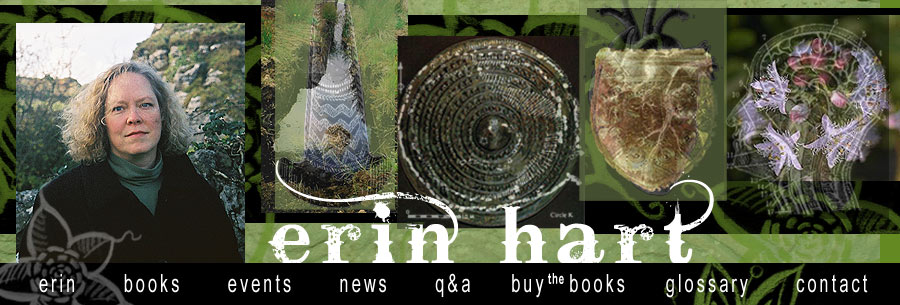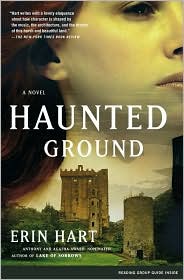Because I know many of you are as geeky about historical detail as I am, I thought I'd share some pictures of the people, places, and artifacts that inspired the story of THE BOOK OF KILLOWEN.
When I thought about writing a story about ancient manuscripts, some of the first objects that snagged my imagination were oak galls, used since ancient times to create ink for writing.
Here's an oak gall, a common growth on oak trees around the world, and a source of basic dark ink from medieval times right up to the 19th century. Many of the monks who created Ireland's ancient manuscripts used iron gall ink. It's not much in favor these days (too acidic - eats through paper), but in the days of calfskin vellum, the tannic acid in the ink bit into the page and made the lettering indelible.
Oak galls are formed when a gall wasp lays her eggs on the tip of an oak branch, and the tree begins to secrete a fluid that ends up enveloping the egg, and ultimately becomes a food source for the developing wasp larva.
Here's how oak galls are described in an old medical text, A History of the Materia Medica, by John Hill, M.D., published in 1751:
[From galla.]
***Galls or galnuts are a kind of preternatural and accidental tumours, produced by the Punctures of Insects on the Oaks of several Species; but those of the oak only are used in medicine. We have two kinds, the Oriental and the European galls: the Oriental are brought from Aleppo, of the bigness of a large nutmeg, with tubercles on their surface, of a very firm and solid texture, and a disagreeable, acerb, and astringent taste. The European galls are of the same size, with perfectly smooth surfaces: they are light, often spongy, and cavernous within, and always of a lax texture. They have a less austere taste, and are of much less value than the first sort, both in manufactures and medicine. The general history of galls is this: an insect of the fly kind, for the safety of her young, wounds the branches of the trees, and in the hole deposites her egg: the lacerated vessels of the tree discharging their contents, form a tumour or woody case about the hole, where the egg is thus defended from all injuries. This tumour also serves for the food of the tender maggot, produced from the egg of the fly, which, as soon as it is perfect, and in its winged state, gnaws its way out, as appears from the hole found in the gall; and where no hole is seen on its surface, the maggot, or its remains, are sure to be found within, on breaking it. It has been observed, that the oak does not produce galls in cold countries: but this observation should be confined to the medicinal galls; for all those excrescences which we find on this tree in our own woods, and call oak-apples, oak-grapes, and oak-cones, are true and genuine galls, though less firm in their texture. The true reason of the hard ones not being produced with us, seems to be that we want the peculiar species of insect to which they owe their origin, which is a fly of the ichneumon kind, only found in hot countries. The species of fly that occasions, by its punctures, the soft galls of France and Italy, is different both from the Syrian one and from ours, though still of the ichneumon kind; and we find the several kinds, which occasion the different galls in our own kingdom, produce different kinds, and those of different degrees of hardness, on the same tree. Galls are used in making ink, and in dying and dressing leather, and many other manufactures. In medicine they are very astringent, and good under proper management.
When the wasp is mature, it bores a hole through the flesh of the gall and escapes, and the gall dries up, leaving a nut-like body rich in tannic acid, the substance that makes them suitable for ink.
Monks and other ink-makers would gather oak galls, and devise an ink using this ancient recipe, taken from a Booke of Secrets:
Iron gall ink was used as the basic dark black/brown ink for countless books, including the Book of Kells and other Irish manuscripts, including the Cathach of Saint Columba, the oldest surviving Irish manuscript.
If you'd like to read more about a modern artist's attempts to make ancient iron gall ink, check out John Daniel's very interesting blog about insects in art, THE ENDLESS SWARM.











stumbled onto your blog doing research on galls. Great post- thanks for the information and great photos/ text scans!
ReplyDeleteDelighted to be able to add a bit to your research. Apparently you can order oak galls online if you'd like to make your own iron gall ink; my aunt ordered a box to use in dried arrangements for my book release party!
ReplyDeleteHello Erin,
ReplyDeleteA lovely write up about galls which I was just teaching my daughter about.Your books sound intriguing. I must get one and start reading.
Yours,
Tony Lawlor,
Clashmore,
Co. Waterford.
Hello Tony -- I'm so sorry, just found your comment today. Glad you and your daughter enjoyed the information about oak galls. I'm fascinated by all the materials the scribes came up with to make words and pictures in their manuscripts. Don't get me started! Anyway, thanks very much for getting in touch. Hope you have withstood all the recent storms.
DeleteAll the best for now,
Erin
Hi Erin,
ReplyDeleteThanks for your kind answer. Yes. We have survived the storms and hopefully the weather systems will begin to moderate in their ferocity as we move farther into the spring.
Thanks again,
Tony.